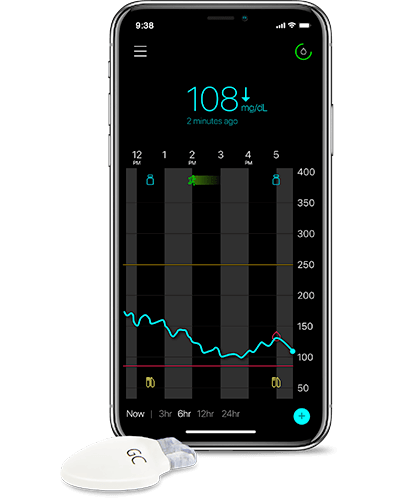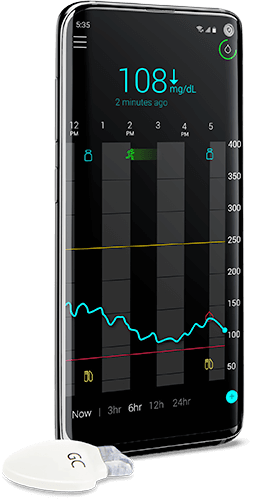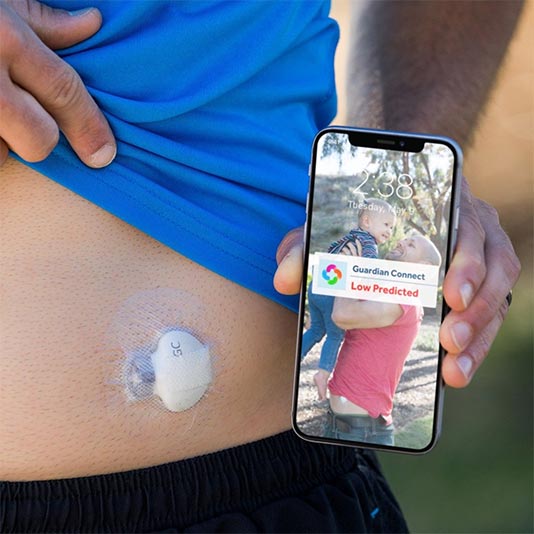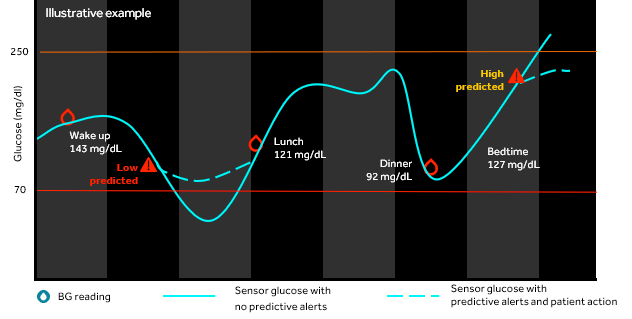What are the benefits of CGM?
Ever taken a fingerstick and wondered, "Am I trending up or trending down? And how fast? What happens to my blood sugar between fingersticks?" Continuous glucose monitoring, or CGM, is a way to measure glucose levels in real time throughout the day and night to help give you the whole picture.


Real-time information for on-the-spot decisions
- A tiny electrode called a glucose sensor is inserted under the skin to measure glucose levels in tissue fluid and is connected to a transmitter that sends the information wirelessly to a smartphone or monitor.
- The device can detect and notify you if your glucose is reaching a high or low limit.
- The latest Medtronic CGM systems can actually alert you up to an hour before you reach your glucose limits.1
A blood glucose meter only provides a brief “snapshot” of your glucose level at a single moment in time. A CGM device, though, gives you a greater view of your glucose trends. CGM provides you with:
- The direction your glucose levels are going
- Early notification of oncoming lows and highs*
- Alerts for lows or highs while you are sleeping or anytime
- Insights into how food, physical activity, medication, and illness impact your diabetes
CGM can provide valuable information at crucial points during the day, including before and during exercise, prior to driving, before test/exam-taking, and in the middle of the night. It is still required to check blood glucose levels with a fingerstick before therapy adjustment.
Reasons to choose Medtronic CGM


Smart†
Predictive alerts for lows/highs
- Helps people act and stay ahead of their diabetes

Simple
Automatic CareLink™ Personal uploads
- Auto-sends text alerts to care partner

Accurate
Accurate for low detection
- Designed with patient safety in mind
- Performance and accuracy when it matters most

Help avoid highs and lows
Low excursions avoided3
High excursions avoided3

* Alerts must be set to receive predictive alerts.
† Smart CGM predicts future high and low sensor glucose events up to 60 minutes in advance.
1 The system is intended to complement, not replace, information obtained from standard blood glucose monitoring devices. All therapy adjustments should be based on measurements obtained from standard blood glucose monitoring devices and not on values provided by the system.
2 Centers for Disease Control and Prevention. National Diabetes Statistics Report, 2020. Atlanta, GA: Centers for Disease Control and Prevention, U.S. Dept of Health and Human Services; 2020.
3 Arunachalam S, Zhong Y, Abraham SB, et al. Poster presented at ADA 2019. 79th Scientific Sessions. June 7th-11th. San Francisco, California. #939-P; Average of 802 matched cohorts, with Sugar.IQ™ app, paired t-test, alerts enabled, ≥ 5 day sensor wear; exogenously administered insulin under direction of a healthcare professional; compare TIR without Sugar.IQ™ app: 59.33%; compare excursions avoided without predicted alerts enabled: 36% low; 11% high. Patients with 5+ days of data. Patients included might be on other diabetes therapy, including insulin pumps, multiple daily injections or oral medications.
Important Safety Information: Guardian™ Connect CGM System
The Guardian™ Connect system requires a prescription and is indicated for continuous or periodic monitoring of glucose levels in the interstitial fluid under the skin, in patients (14 to 75 years of age) with diabetes mellitus. The system is intended to complement, not replace, information obtained from standard blood glucose monitoring devices, and is not recommended for people who are unwilling or unable to perform a minimum of two meter blood glucose tests per day, or for people who are unable or unwilling to maintain contact with their healthcare professional. The system requires a functioning mobile electronic device with correct settings. If the mobile device is not set up or used correctly, you may not receive sensor glucose information or alerts. For complete details of the system and its components, including warnings, contraindications, and precautions, please consult the user guide at http://www.medtronicdiabetes.com/support/download-library/user-guides and important safety information.


